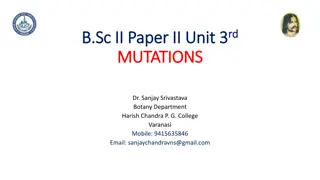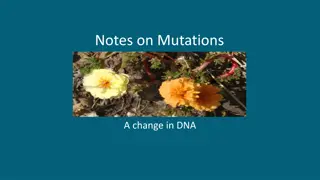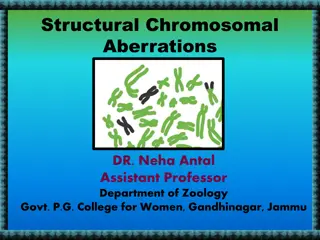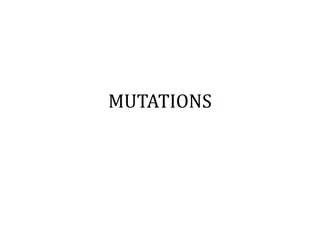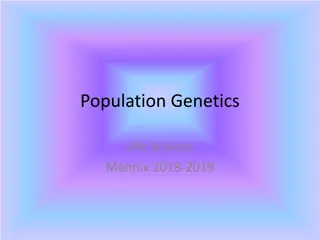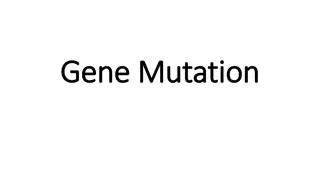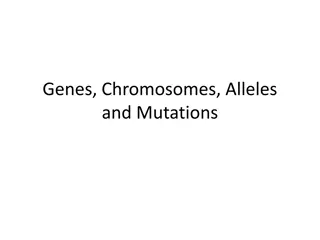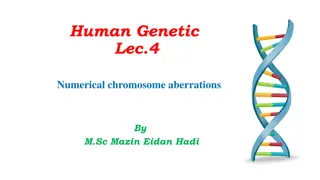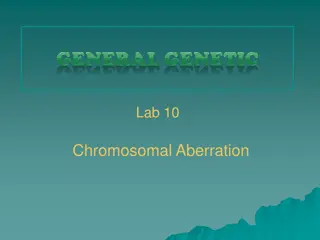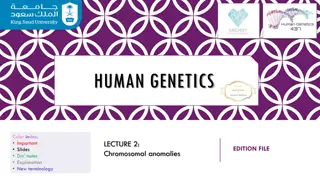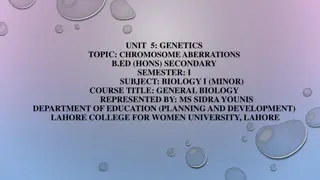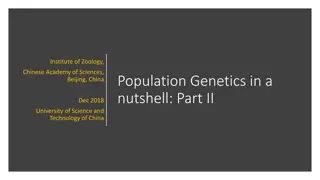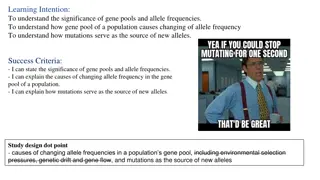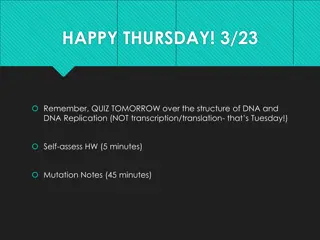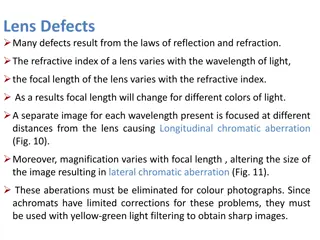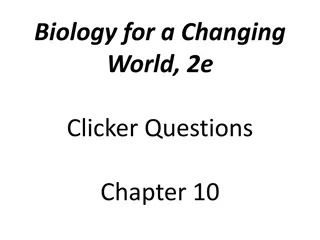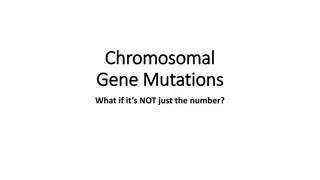Understanding Genetics: Mutations, Chromosomal Aberrations, and Genetic Engineering
Genetic mutations can be harmless, harmful, or beneficial, leading to variations within a species. Examples of gene mutations and chromosomal aberrations, like Trisomy 21, illustrate genetic abnormalities. The increase in Down Syndrome cases with maternal age highlights a maternal age effect. Genetic engineering terms, including biotechnology and cloning, play a crucial role in manipulating DNA for various purposes. Stem cells research and ethical considerations are also significant in the field of genetics.
Download Presentation

Please find below an Image/Link to download the presentation.
The content on the website is provided AS IS for your information and personal use only. It may not be sold, licensed, or shared on other websites without obtaining consent from the author. Download presentation by click this link. If you encounter any issues during the download, it is possible that the publisher has removed the file from their server.
E N D
Presentation Transcript
ASSET GRADE 12 LIFE SCIENCES REVISION 2020 GENETICS PART 3 For each section please read the exam guidelines first before going on to the content. Learn all the content in this presentation
Mutations Genetic Mutations are alterations in the DNA of chromosomes/genes Mutations may be: Harmless (neutral or 'silent ) i.e. they have no observable effect on the organism. Harmful mutations become evident because they may lower the chances of survival of an organism. If these are passed on to offspring, they usually cause death. Useful (beneficial) mutations may increase the chances of survival of an organism and of a species. Chromosomal aberrations occur when the structure of a chromosome is affected or a whole chromosome is added to or lost from the karyotype In both cases, they contribute to genetic variation in the offspring because they change the genotype or karyotype of the offspring and this is passed on through reproduction. This results in variation within a species
Example of a chromosomal aberration to learn Aneuploidy: The loss or gain of whole chromosomes can take place Example is Trisomy 21 or Down Syndrome Caused by Non disjunction during Anaphase 1 or 2 in Meiosis Look at chromosome 21 on the karyotype
Trisomy 21/Down Syndrome Many aberrations show a maternal age effect , where incidence increases with the age of the mother. Can you interpret this graph and describe the trend shown?
Genetic Engineering terminology to know Biotechnology is the use of living systems and organisms to develop or make products, Genetic Engineering is the artificial manipulation of genes, adding or subtracting genetic material. Genetically Modified Organism (GMO s)/ Transgenic Organisms Organisms that have had their DNA artificially manipulated. Cloning (genetic or molecular) A molecular process in which DNA sequences are replicated within host organisms or in vitro. Selective Breeding The artificial breeding of plants and animals for particular traits. Stem Cells An undifferentiated cell from a multi-cellular organism that has the potential to give rise to infinite numbers of the same cell and from which certain other kinds of cells arise from differentiation. Ethics The branch of knowledge that deals with moral principles.
Stem cells and research: Sources and uses C:\Users\gnoel\AppData\Local\Temp\msohtmlclip1\01\clip_image001.png Definition: Stem cells are undifferentiated cells from a multi-cellular organism that has the potential to give rise to infinite numbers of the same cell and from which certain other kinds of cells arise from differentiation. Two kinds to learn 1. Embryonic stem cells
2. Adult stem cells C:\Users\gnoel\AppData\Local\Temp\msohtmlclip1\01\clip_image001.png
Uses of stem cells Stem cells can be used in therapeutic treatment such as treating people with leukaemia and in bone marrow transplants Some future treatments could be to Regenerate damaged nerve tissues like when a person has a broken spine Treat people with Alzheimer s disease Treat people with Parkinson s disease
Genetically modified organisms brief outline of process (names of enzymes involved are not required) and benefits of genetic modification - see next slide as well
In genetic modification, scientists use restriction enzymes to isolate a segment of DNA that contains a particular gene of interest (1). In this instance, it is a human gene. A plasmid extracted from its bacteria and treated with the same restriction enzyme can hybridize with this fragment s sticky ends of complementary DNA (2). The hybrid plasmid is reincorporated into the bacterial cell, where it replicates as part of the cell s DNA (3). A large number of daughter cells can be cultured and studied, and their gene products may be extracted for further use (4).
Cloning brief outline of process and benefits of cloning A nucleus from a donor adult diploid cell is transferred into an egg cell that has no nucleus. The egg cell divides by mitosis to become a copy of the original donor cell. This is transferred into the uterus of a female of the same species in order to develop into an embryo which is born normally. Who is the mother?
Paternity testing Why isn t there maternity testing? In the cases the mother gives birth to a child there is no need for maternity testing. However, in the case of adopted children or in natural disaster when children are separated from their parents, then maternity testing is necessary as well. Describe the role of blood group in paternity testing and in each case say how accurate the characteristic could be in proving paternity of a child There are 4 main blood groups (phenotypes): A, B, O and AB And 6 possible genotypes: IAIA OR Iai, IBIB OR Ibi, ii and IAIB Often is easier to say who is NOT the father than who IS the father. Describe the role of DNA profiles in paternity testing and in each case say how accurate the characteristic could be in proving paternity of a child. Start by looking at the bars of different colours/thicknesses/positions in the potential fathers DNA profile and look for the similarities in each of the children s DNA profiles. The higher the similarity of bars when comparing the potential father and children the greater chance of paternity. Usually above 90% is considered reliable.
Genetic links specifically in mitochondrial DNA (mtDNA) NB: Mutations occur more regularly and at a fixed rate in mtDNA. When mutations occur, these show how closely or distantly organisms/species are related.



